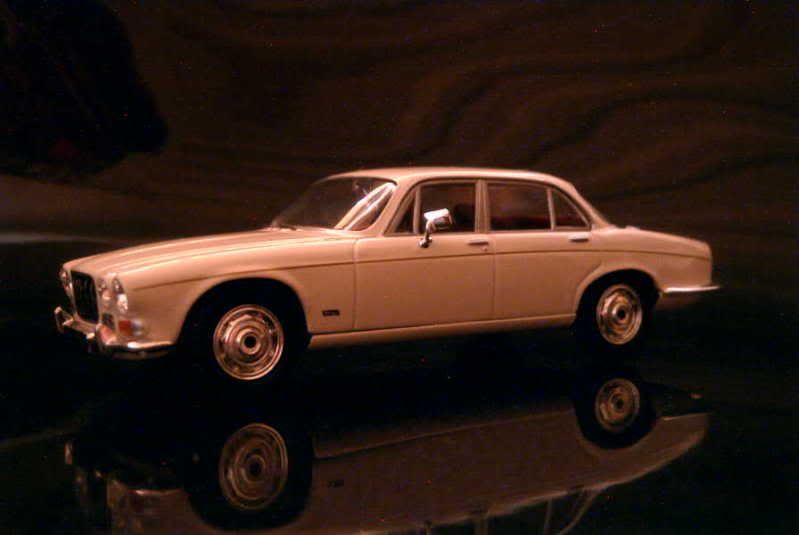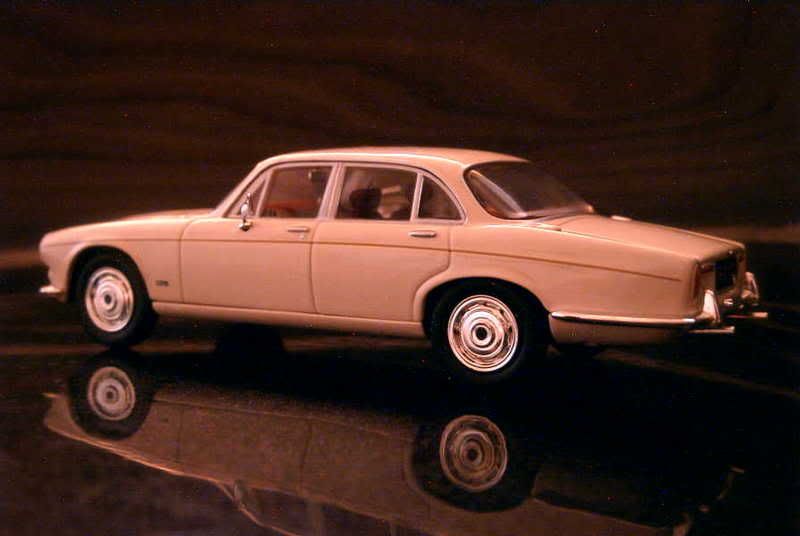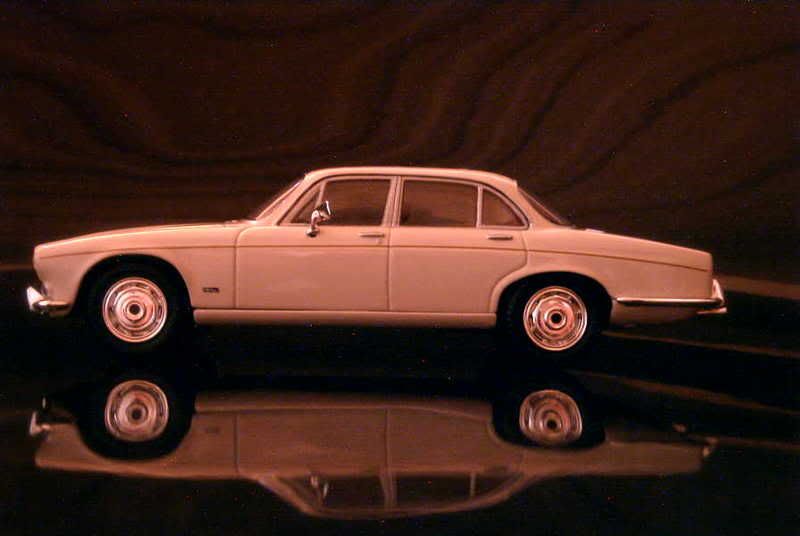A little history
One of the most famous cars in automobile history, the Jaguar XJ series was born out of the realization by the company’s management, some time during the mid-Sixties, that their range had to be rationalized. Apart from the top-of-the-line Mk.X, the fastest four-door saloon in the world at the time of its launch, and the famed E-Type coupes and convertibles, no less than three distinct (though related) cars were produced in the entry-level range. The smallest engines which powered these cars were either a 2.4-litre, 6-cylinder block by Jaguar or a 2.5-litre V8 provided by Daimler. Competition on the domestic market, most notably by Rover and Triumph, was becoming harsh in this field. Therefore Jaguar decided to aim higher, but such a replacement, with probably a 3.0 to 3.5-litre engine under its bonnet, would have been too close from the Mk.X. Therefore, it was decided to replace all saloons in production by a single offer, the XJ6.
For the time being, the project was called XJ4. There was nothing revolutionary about the car – Jaguar just included in it all what it knew how to do best. Power would come from a brand new 4.2-litre inline six good for 173 bhp. Aiming mostly at those foreign markets where high taxes were imposed on cars with large displacements, a 2.8-litre engine was also offered.
Sir William Lyons, founder and president of Jaguar, is credited with the XJ4 styling, as he personally oversaw the design of its body. On the outside, the XJ4 took most of its stylistic cues from the Mk.X, only as a lighter, elongated, updated package. The rear section, on the other hand, was inspired by the E-Type tail, with its end chopped off.
Finally named XJ6 in reference to its 6-cylinder engine (with V8 and V12 engines being scheduled, this would help for naming these variants when released), the new Jaguar saw its debut in September 1968. Though no road test was initially organized for the press, the company’s reputation and the word of mouth guaranteed a long waiting list to the XJ6. When journalists finally got their hands on the car, they praised what its first customers had found when they had taken delivery of theirs: excellent performance, good handling, and extraordinary comfort highlighted by almost complete quietness inside the passenger compartment. To make things even better the XJ6, continuing the long Jaguar tradition of offering the best car at the best price, was relatively cheap with regards to its competitors. On the long run though, XJ6 drivers would find that, as many other Jaguars, the construction quality of their cars left much to be desired.
In July 1972, Jaguar presented the XJ12, powered by a 5.3-litre V12. The V8 project had been axed shortly beforehand. Even more powerful and silent than the 6-cylinder block, the V12 was a bottomless pit when it came about fuel consumption. Nobody really cared in 1972, but less than one year and a half later…
Other variants added over time included a long-wheelbase saloon and a short-lived XJ-C coupe. Daimler, which was building a slightly more expensive XJ6 as the Sovereign, also added a XJ12 equivalent to its range, under the prestigious name Double Six. The look of the car also evolved. In September 1973, new American regulations induced a facelift, the front bumper, now too low to comply with U.S. rules, being set higher below a smaller grille.
When the oil crisis erupted in late 1973, a Jaguar customer had to wait for two years and a half before his or her vehicle could be delivered. Though the company never encountered much trouble with unsold cars during the rest of the Seventies, various adverse elements played against it during that time, apart from the crisis itself. Rife throughout Britain, social unrest limited productivity. Jaguar's new boss, Geoffrey Robinson, tried to increase the company's production in order to satisfy the demand, which affected quality even further. Even more disturbing was the fact that, virtually bankrupt, struggling British Leyland could not afford to finance a replacement for the XJ, which had to carry on for a few more years, while the company’s main rivals, Mercedes-Benz and BMW, were enjoying increasing shares of the luxury car market. Afraid at a complete collapse of BLMC, supported by taxpayers’ money, the British government commissioned Sir Don Ryder to present a report on the group’s future: one measure that followed the publication of this report in April 1975 was the creation of British Leyland Cars, within which all BLMC companies lost their autonomy – a disastrous development for Jaguar. Fortunately this reorganization would be abolished in early 1978.
In March 1979, Jaguar had succeeded in gathering enough resources – actually, most of what was left – to introduce a Series 3 of its XJ. The third incarnation of the car featured a new roofline, due to Pininfarina. The tasteful update was just what the car needed to extend its career long enough for a successor to be designed. Though paint finish problems marred the Series 3’s debut, sales were soon following an ascendant curve. The venerable automobile would remain basically untouched during its last years in production, the only major improvement the XJ12 received being, in late 1981, high-compression cylinder heads that boosted the output to 299 bhp. This improvement was due to a Swiss engineer named Michael May; history has not been good to him as he is also credited for fitting the very first air wing to his own Porsche spyder in the mid-Fifties, and driving in Formula One during the early Sixties: a rather busy life dedicated to automobile!
Though a new XJ40 was finally introduced in 1986, the old XJ6/12 was kept in production. The XJ6 lingered until the new car had been introduced to all foreign markets, finally retiring in May 1987. The 12-cylinder variant was to be built even longer, as an equivalent version for the XJ40, named XJ81, still wasn’t ready for production. The project was cancelled after American giant Ford purchased Jaguar in late 1989, allowing the XJ12 and its cousin the Double Six to remain on the market until 1992.
Over close to a quarter of a century in production, the Jaguar XJ had become one of the most iconic automobiles Britain ever produced. One of the most meaningful signs of its success is the simple fact that, as only few other models did, it survived British Leyland’s disintegration during the Seventies and Eighties.
About the model
Model: Jaguar XJ6
Year: 1968
Maker: Vanguards - Corgi
Scale: 1/43
Distributed by: Vanguards
Acquired: brand new, in January 2007, in Hong Kong, S.A.R.
An exceptional model throughout, particularly considering its price. From whatever angle you look at it, Vanguards' rendition of a first series XJ is beautiful. This would perhaps sounds even more credible if I'd confess that I've never been fond the real car! I'd easily give a 15/20 rating. Note that Vanguards also offers a Daimler Sovereign on the same base, fitted with a different radiator grille.



One of the most famous cars in automobile history, the Jaguar XJ series was born out of the realization by the company’s management, some time during the mid-Sixties, that their range had to be rationalized. Apart from the top-of-the-line Mk.X, the fastest four-door saloon in the world at the time of its launch, and the famed E-Type coupes and convertibles, no less than three distinct (though related) cars were produced in the entry-level range. The smallest engines which powered these cars were either a 2.4-litre, 6-cylinder block by Jaguar or a 2.5-litre V8 provided by Daimler. Competition on the domestic market, most notably by Rover and Triumph, was becoming harsh in this field. Therefore Jaguar decided to aim higher, but such a replacement, with probably a 3.0 to 3.5-litre engine under its bonnet, would have been too close from the Mk.X. Therefore, it was decided to replace all saloons in production by a single offer, the XJ6.
For the time being, the project was called XJ4. There was nothing revolutionary about the car – Jaguar just included in it all what it knew how to do best. Power would come from a brand new 4.2-litre inline six good for 173 bhp. Aiming mostly at those foreign markets where high taxes were imposed on cars with large displacements, a 2.8-litre engine was also offered.
Sir William Lyons, founder and president of Jaguar, is credited with the XJ4 styling, as he personally oversaw the design of its body. On the outside, the XJ4 took most of its stylistic cues from the Mk.X, only as a lighter, elongated, updated package. The rear section, on the other hand, was inspired by the E-Type tail, with its end chopped off.
Finally named XJ6 in reference to its 6-cylinder engine (with V8 and V12 engines being scheduled, this would help for naming these variants when released), the new Jaguar saw its debut in September 1968. Though no road test was initially organized for the press, the company’s reputation and the word of mouth guaranteed a long waiting list to the XJ6. When journalists finally got their hands on the car, they praised what its first customers had found when they had taken delivery of theirs: excellent performance, good handling, and extraordinary comfort highlighted by almost complete quietness inside the passenger compartment. To make things even better the XJ6, continuing the long Jaguar tradition of offering the best car at the best price, was relatively cheap with regards to its competitors. On the long run though, XJ6 drivers would find that, as many other Jaguars, the construction quality of their cars left much to be desired.
In July 1972, Jaguar presented the XJ12, powered by a 5.3-litre V12. The V8 project had been axed shortly beforehand. Even more powerful and silent than the 6-cylinder block, the V12 was a bottomless pit when it came about fuel consumption. Nobody really cared in 1972, but less than one year and a half later…
Other variants added over time included a long-wheelbase saloon and a short-lived XJ-C coupe. Daimler, which was building a slightly more expensive XJ6 as the Sovereign, also added a XJ12 equivalent to its range, under the prestigious name Double Six. The look of the car also evolved. In September 1973, new American regulations induced a facelift, the front bumper, now too low to comply with U.S. rules, being set higher below a smaller grille.
When the oil crisis erupted in late 1973, a Jaguar customer had to wait for two years and a half before his or her vehicle could be delivered. Though the company never encountered much trouble with unsold cars during the rest of the Seventies, various adverse elements played against it during that time, apart from the crisis itself. Rife throughout Britain, social unrest limited productivity. Jaguar's new boss, Geoffrey Robinson, tried to increase the company's production in order to satisfy the demand, which affected quality even further. Even more disturbing was the fact that, virtually bankrupt, struggling British Leyland could not afford to finance a replacement for the XJ, which had to carry on for a few more years, while the company’s main rivals, Mercedes-Benz and BMW, were enjoying increasing shares of the luxury car market. Afraid at a complete collapse of BLMC, supported by taxpayers’ money, the British government commissioned Sir Don Ryder to present a report on the group’s future: one measure that followed the publication of this report in April 1975 was the creation of British Leyland Cars, within which all BLMC companies lost their autonomy – a disastrous development for Jaguar. Fortunately this reorganization would be abolished in early 1978.
In March 1979, Jaguar had succeeded in gathering enough resources – actually, most of what was left – to introduce a Series 3 of its XJ. The third incarnation of the car featured a new roofline, due to Pininfarina. The tasteful update was just what the car needed to extend its career long enough for a successor to be designed. Though paint finish problems marred the Series 3’s debut, sales were soon following an ascendant curve. The venerable automobile would remain basically untouched during its last years in production, the only major improvement the XJ12 received being, in late 1981, high-compression cylinder heads that boosted the output to 299 bhp. This improvement was due to a Swiss engineer named Michael May; history has not been good to him as he is also credited for fitting the very first air wing to his own Porsche spyder in the mid-Fifties, and driving in Formula One during the early Sixties: a rather busy life dedicated to automobile!
Though a new XJ40 was finally introduced in 1986, the old XJ6/12 was kept in production. The XJ6 lingered until the new car had been introduced to all foreign markets, finally retiring in May 1987. The 12-cylinder variant was to be built even longer, as an equivalent version for the XJ40, named XJ81, still wasn’t ready for production. The project was cancelled after American giant Ford purchased Jaguar in late 1989, allowing the XJ12 and its cousin the Double Six to remain on the market until 1992.
Over close to a quarter of a century in production, the Jaguar XJ had become one of the most iconic automobiles Britain ever produced. One of the most meaningful signs of its success is the simple fact that, as only few other models did, it survived British Leyland’s disintegration during the Seventies and Eighties.
About the model
Model: Jaguar XJ6
Year: 1968
Maker: Vanguards - Corgi
Scale: 1/43
Distributed by: Vanguards
Acquired: brand new, in January 2007, in Hong Kong, S.A.R.
An exceptional model throughout, particularly considering its price. From whatever angle you look at it, Vanguards' rendition of a first series XJ is beautiful. This would perhaps sounds even more credible if I'd confess that I've never been fond the real car! I'd easily give a 15/20 rating. Note that Vanguards also offers a Daimler Sovereign on the same base, fitted with a different radiator grille.






2 comments:
hi amigo! I agree with your point about the vanguards jaguar. I have it and I consider one of the best jaguars of my collection.
I also like your stile to make entries.
My kindest regards to you.
Hello Gaucho Man! Thank you very much for your kind comments, and welcome to this blog. I hope to read again from you in the near future!
Regards,
Lorenzo.
Post a Comment